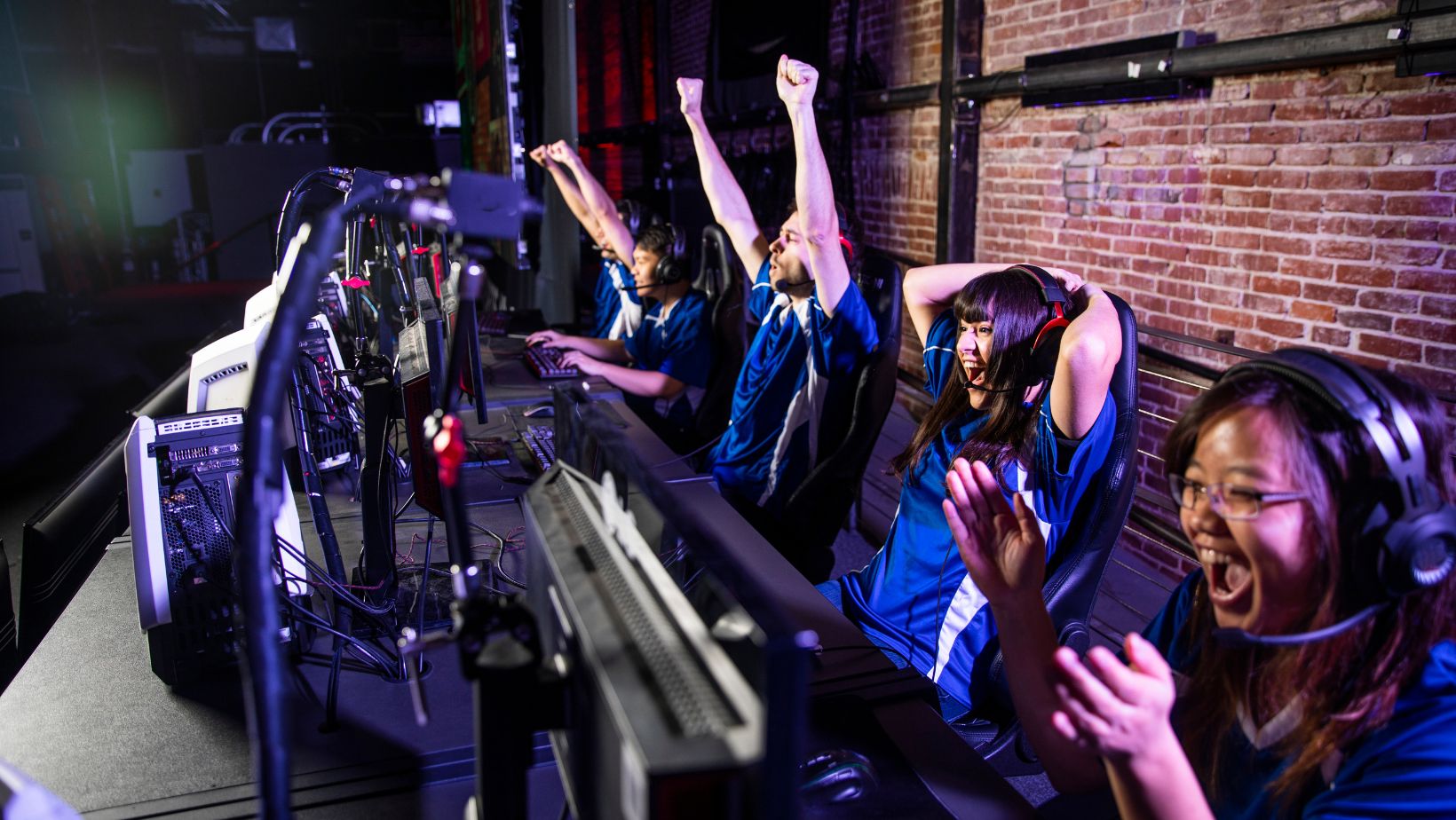The Rise of Esports
What began as small, informal gatherings of passionate gamers has now transformed into a global spectacle that rivals traditional sports in scale and popularity. Esports, or competitive gaming, has undergone a meteoric rise, captivating millions of fans worldwide and giving birth to an entirely new entertainment industry. With professional leagues, high-stakes tournaments, and multi-million-dollar prize pools, esports has evolved from its humble origins to become a major player on the global stage. In this article, we’ll explore how esports tournaments have progressed from local community events to international arenas that capture the attention of audiences across the globe.
The Early Days: Local and Grassroots Tournaments
In the early days of esports, competitive gaming was far from the massive industry it is today. Back then, tournaments were small, often organized by local gaming communities or groups of friends gathering at LAN parties. These grassroots events were the lifeblood of early competitive gaming, where players would compete face-to-face, connecting their computers in basements, community centers, or small gaming cafes. While the prize pools were modest, the passion and excitement were immense. These early tournaments laid the foundation for what would later become a global phenomenon.
Local tournaments were also pivotal in building strong player communities. Gamers who participated in these events were driven by a love for the game, and their shared experiences fostered tight-knit networks of competitors and fans. It was during this time that esports started to take shape, slowly drawing the attention of more serious players and organizers. The arrival of sponsorships, small media coverage, and growing online discussions marked a shift towards a more structured scene.
As esports gained momentum, platforms, and events that supported betting on the outcomes of matches began to emerge, providing another layer of excitement for spectators. Today, some modern esports fans can engage with tournaments in various ways, such as through platforms like Mostbet, further demonstrating how far the industry has come since its humble beginnings. The spirit of those early local tournaments, however, remains a crucial part of the esports culture, reminding players and fans alike of where it all started.
The Birth of Professional Leagues
As esports continued to grow from grassroots events, the demand for more structured and professional competitions became inevitable. The early 2000s saw the birth of professional esports leagues, marking a significant turning point in competitive gaming. Pioneering games like StarCraft, Counter-Strike, and Warcraft III began to attract serious attention, with organized leagues such as Major League Gaming (MLG) and the Cyberathlete Professional League (CPL) setting the stage for a more formalized esports landscape.

These leagues introduced a new level of professionalism to esports, including structured seasons, rankings, and larger prize pools. Players began to pursue esports as a legitimate career path, with the best teams and individuals signing sponsorship deals and contracts, paving the way for the multimillion-dollar tournaments that are common today. As leagues grew in popularity, international exposure followed, with tournaments being broadcasted to a global audience, thanks to streaming platforms like Twitch and YouTube.
As professional leagues became more established, they began to set the standard for how esports would be viewed and consumed by a larger audience. What was once a collection of independent events transformed into a well-oiled machine with formal organizations, standardized rules, and consistent schedules. The establishment of leagues like the Electronic Sports League (ESL) and the rise of game-specific leagues such as the League of Legends Championship Series (LCS) and Dota 2’s The International created distinct ecosystems for each game, where the best players could compete at the highest levels.
These leagues introduced regular season play, playoffs, and grand finals, much like traditional sports leagues, which allowed fans to follow their favorite teams and players throughout the year. Sponsorship deals became more significant, allowing teams to thrive financially and players to earn salaries on par with those of traditional athletes.
This shift toward professionalization also saw the development of training facilities, coaching staff, and support teams dedicated to helping players perform at their peak. It wasn’t just about playing for fun anymore—esports athletes were now being treated as serious competitors. This era also marked the point when large-scale media coverage and corporate investment began to flood the industry, giving esports the resources to expand even further.
With the rise of betting platforms like Mostbet, spectators found new ways to engage with their favorite tournaments, adding an extra layer of excitement to every match. The ability to bet on esports matches drew in even more viewers, further validating the competitive gaming industry’s growth. The birth of professional leagues cemented esports’ place in the global entertainment landscape, and it continues to evolve, breaking new boundaries with each passing year.
Esports Goes Global: International Competitions
The global expansion of esports truly began when international competitions started to capture the attention of audiences worldwide. No longer confined to local events or regional tournaments, esports began to showcase its power on the world stage. The introduction of major tournaments like The International for Dota 2 and the League of Legends World Championship turned esports into a global spectacle, attracting millions of viewers and offering prize pools that rivaled some of the largest sporting events.
These international competitions brought together the best teams from different countries, pitting them against each other in electrifying matchups. The prestige associated with winning such tournaments grew rapidly, and teams invested heavily in preparation, strategy, and player development to secure their place at the top. As a result, the level of competition skyrocketed, with many matches becoming intense, high-stakes battles that captivated audiences from all over the globe.
The rise of streaming platforms like Twitch and YouTube also played a crucial role in making these international competitions accessible to a worldwide audience. Fans from every corner of the globe could now watch their favorite teams and players compete in real-time, fueling the rapid growth of the esports community.
Alongside this growth, various industries began to recognize the potential of esports, including the betting and casino sectors, which allowed fans to engage with the action on a different level. For example, some platforms even provided opportunities for spectators to Maximizing casino bonuses through esports-related promotions, adding an extra layer of excitement to these international events.
Esports has now firmly established itself as a global force, with competitions held in some of the world’s largest arenas, from New York to Seoul, and drawing viewership numbers comparable to those of traditional sports. The future of esports looks even brighter as international competitions continue to evolve and attract new fans from across the world.
The Future of Esports Tournaments
The future of esports tournaments is poised to be even more dynamic and revolutionary as technological advancements and global interest continue to propel the industry forward. As esports gains recognition on par with traditional sports, new opportunities are emerging that will redefine how tournaments are organized, played, and consumed.

One of the most significant trends shaping the future of esports is the increasing integration of cutting-edge technology. Virtual reality (VR) and augmented reality (AR) are set to transform the gaming experience by offering players and fans more immersive environments. VR esports tournaments could become the next frontier, where competitors engage in fully immersive 3D worlds, blurring the lines between reality and the digital realm. Meanwhile, advancements in 5G and cloud gaming will allow for smoother, more accessible competitions across the globe, reducing latency and enabling players from different regions to compete seamlessly.
Another major shift will be the expansion of mobile esports. As smartphones become more powerful, mobile gaming is exploding in popularity, especially in regions like Southeast Asia, Latin America, and Africa. Tournaments centered around mobile games are expected to grow, providing new opportunities for players who may not have access to traditional gaming consoles or PCs. This could lead to a more democratized esports landscape, where a new wave of players can rise to stardom from anywhere in the world.
The increasing involvement of traditional sports organizations, major corporations, and governments is also paving the way for esports to enter mainstream culture. With sponsorships, advertising, and media rights deals on the rise, esports tournaments are set to become more lucrative and widely televised, much like traditional sports leagues. Additionally, discussions about esports’ inclusion in major sporting events like the Olympics indicate that the competitive gaming industry could soon share a global stage with the most prestigious athletic competitions.
Finally, fan engagement will continue to evolve with advancements in streaming technology, interactive platforms, and social media. Fans will have more ways than ever to connect with their favorite teams and players, from personalized viewing experiences to participating in live chats, polls, and virtual meet-and-greets. The sense of community that esports has fostered will only grow stronger as fans around the world engage with tournaments in innovative new ways. The future of esports tournaments is set to be more immersive, inclusive, and expansive, reaching new heights as technology and global interest continue to fuel its evolution. As the boundaries of competitive gaming are pushed further, esports will undoubtedly become an even more dominant force in the world of entertainment.




















